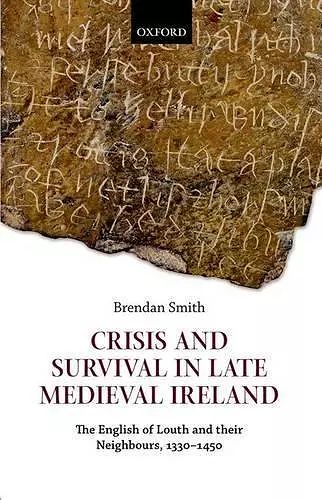Crisis and Survival in Late Medieval Ireland
The English of Louth and Their Neighbours, 1330-1450
Format:Hardback
Publisher:Oxford University Press
Published:20th Jun '13
Currently unavailable, and unfortunately no date known when it will be back

Medieval Ireland is associated in the public imagination with the ruined castles and monasteries that remain prominent in the Irish landscape. Crisis and Survival in Late Medieval Ireland: The English of Louth and their Neighbours, 1330-1450 examines how the society that produced these monuments developed over the course of a turbulent century, focussing particularly on county Louth, situated on the coast north of Dublin and adjacent to the earldom of Ulster. Louth was one of the areas that had been most densely colonised by English settlers in the decades around 1200, and ties with England and loyalty to the English crown remained strong. Its settlers found it possible to maintain close economic and political ties with England in part because of their proximity to the significant trading port of Drogheda, and the residence among them of the archbishop of Armagh, primate of Ireland, also extended their international horizons and contacts. In this volume, Brendan Smith explores the ways in which the English settlers in Louth maintained their English identity in the face of plague and warfare. The Black Death of 1348-9, and recurrent visitations of plague thereafter, reduced their numbers significantly and encouraged the Irish lordships on their borders to challenge their local supremacy. How to counter the threat from the MacMahons, O'Neills, and others, absorbed their energies and resources. It not only involved mounting armed campaigns, taking hostages, and building defences; it also meant intermarrying with these families and entering into numerous solemn, if short-lived, treaties with them. Smith draws on original source material, to present a picture of the English settlers in Louth, and to show how living in the borderlands of the English world coloured every aspect of settler life.
An outstanding piece of local history based upon extensive archival and secondary research, and supported by a full scholarly apparatus of maps, footnotes, bibliography, and index ... Highly recommended. * A.C. Reeves, CHOICE *
Smith has thus produced a work with broad appeal and provides food for thought. Highly recommended. * Linda E. Mitchell, The Medieval Review *
...a painstakingly well-researched and scholarly work that will quickly become indispensable to historians of later medieval Ireland. The truly impressive prosopographical work that Smith uses as the backbone of his study is characterized by a level of detail and specificity missing from many studies of regional communities and provides an excellent roadmap for such research going forward. * Sparky Booker, Economic History Review *
This study is a model of how medieval history should be written, whereby the experience of one local community illuminates a much broader landscape. * Dr Colman O Clabaigh, The Tablet *
carefully nuanced study ... rich in ideas and evidence ... deserves the close attention of everybody interested in the modulations of government and society across the dominions of the late medieval English crown. * Robin Frame, English Historical Review *
Brendan Smith has made a major contribution to the study of English communities in medieval Ireland, illustrating the resilience of their identity despite the challenges that faced them on the march or in the council chamber. * Emmett O'Byrne, American Historical Review *
What is impressive here is Smith's control of scattered and often fragmentary archival sources. * Peter Crooks, History *
ISBN: 9780199594757
Dimensions: 240mm x 162mm x 24mm
Weight: 612g
280 pages